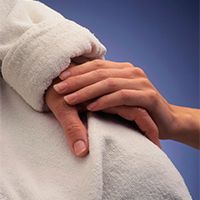Caring for the (Cancer) Caregiver
When we think about the stresses and strains on cancer caregivers in the dawn of the 21st century, the compounded demands on their time and resources must be a first and primary focus.
Caring for the Cancer Caregiver

Nearly 40 years ago I saw my first face of cancer. It was the face of my quick-witted aunt, Dora, the chemist among my father's siblings, sequestered, sullen and ravaged by the chemo she endured. In the 1970s, cancer care was marked by such brutal fights with the therapies as much as with the cancer itself. Back then there was just over a 20% chance that a woman like my aunt would survive 10 years in.
My aunt was lucky in many ways though; she was one of three adult, unmarried sisters, living in their Italian mother's home, with a family business right next door, so the tight knit sorority was able to foster the necessary mutual support. Nilda, Elvira, and their mother, whom we all knew as Nonna, gave their time to caring for Dora through her treatment and eventual death.
With survival rates for cancers on the rise since those dark days, the task of caregivers has hardly matched the transformation in treatments. If anything, treatments extend longer, convalescence and recovery following right along, and the complications, both financial and in terms of medical knowledge for the caregiver, are much more complex in this new digital age.
So when we think about the stresses and strains on cancer caregivers in the dawn of the 21st century, the compounded demands on their time and resources must be a first and primary focus. As a society we still don't really acknowledge caregivers because in economic terms there is no "product" being produced. However, as a whole, caregivers in America constitute a large and growing workforce as the baby boom generation gets progressively older.
Demands on time have their own singular impacts as well. Caregivers suffer from social isolation like no other population. The urgency of medical needs for the patient will most often eclipse the basic health needs of the caregiver leading to further isolation, burnout, and psychological distress. And if the patient isn't as lucky as my Aunt Dora, there won't be three family members in the house to rotate the duties. What is much more common is that one member of the family takes on (or is foisted into) the role of caregiver, while the other members of the family take a breath and keep running in their daily lives. Most times, supportive family members aren't aware of the onslaught of paperwork and the wave of additional tasks that caregivers are saddled with.
At The Caregiver Space, we seek to shine a spotlight on the hidden work of caregivers, build a community from which caregivers can be supported, and help provide ideas and solutions so that caregivers can rise to the challenges before them.
On Tuesday evening, September 13th, we're participating in a live tweet chat. It's a digitized brain trust: "Caring for the (cancer) Caregiver", hosted by CURE Magazine, Oncology Nursing News, and featuring The Caregiver Space using the hashtag #CureConnect.

